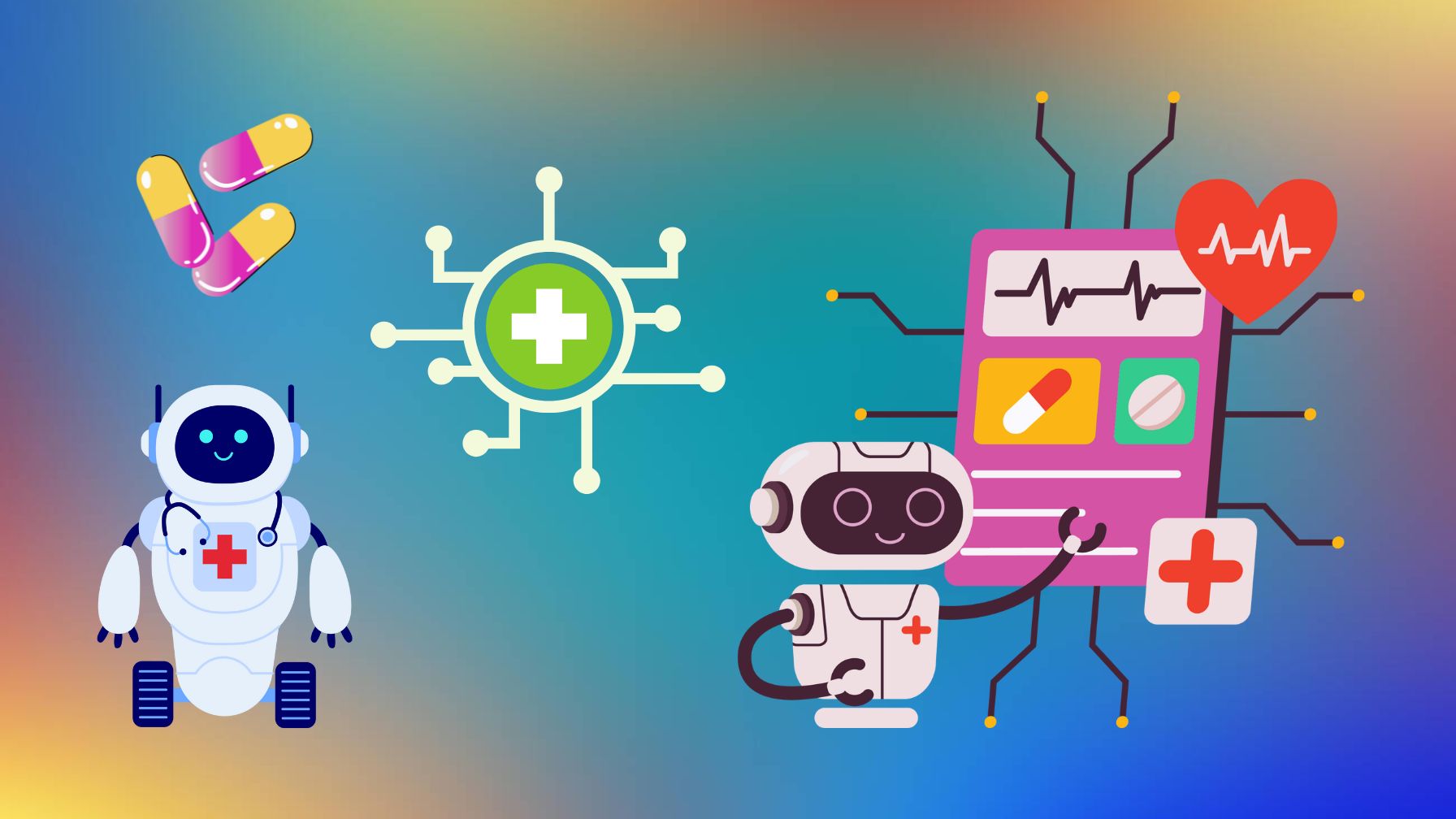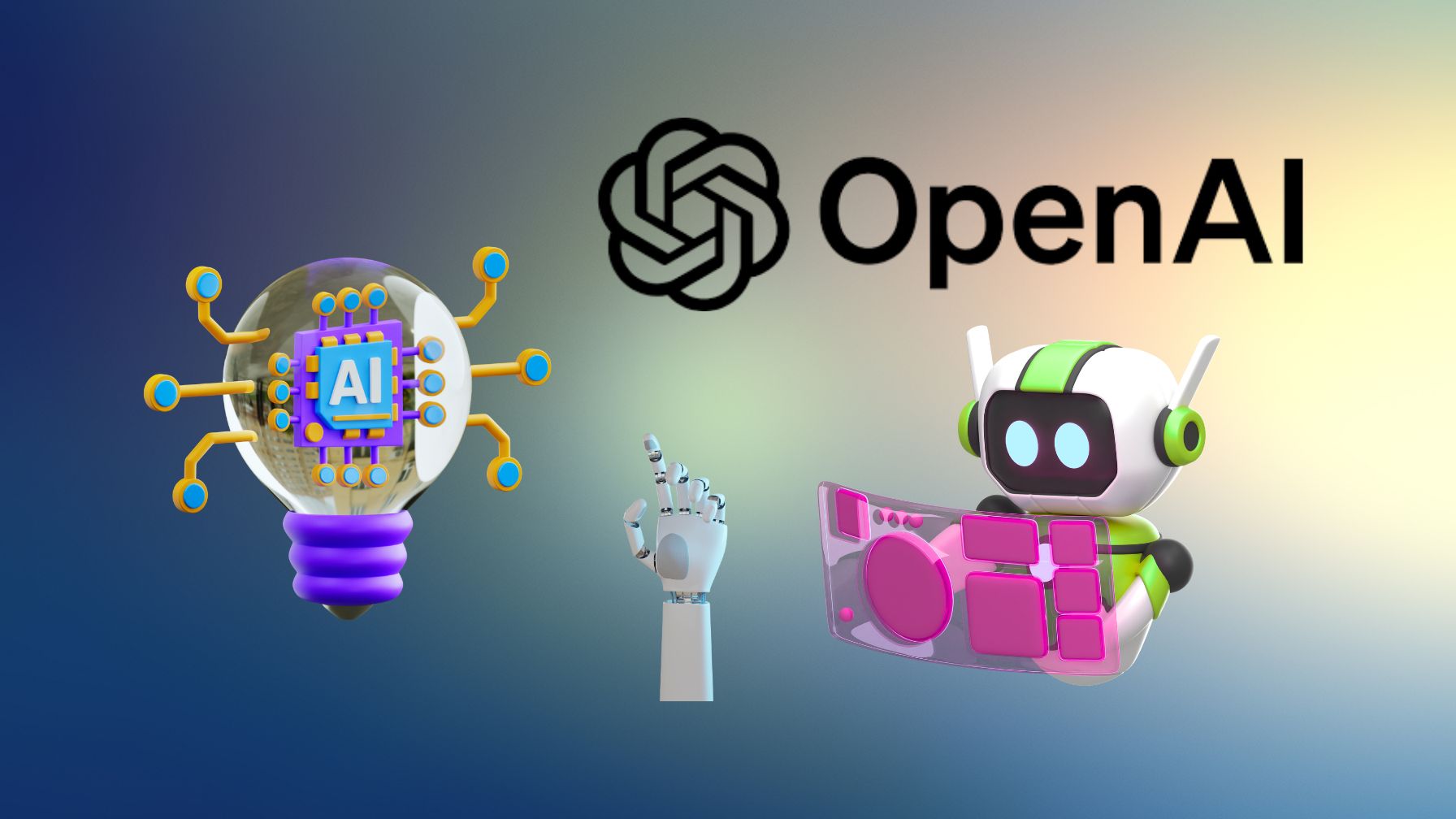Imagine a world where your doctor’s diagnosis is assisted by a machine learning model, your home anticipates your needs before you speak, and your company’s biggest asset is no longer its workforce, but its data. That’s not a glimpse of a distant future; it’s the reality we’re living in. As artificial intelligence (AI) rapidly weaves into the fabric of our daily lives, 2025 is shaping up to be a pivotal year. From expanding market size to ethical debates, AI continues to evolve, bringing innovation, disruption, and opportunities across industries.
This article dives deep into the latest AI statistics for 2025, helping you understand how it’s transforming sectors and what that means for the future of business, technology, and society.
Editor’s Choice
Here are the most striking AI stats of 2025, curated for instant insight:
- The global AI market is projected to reach $407 billion in 2025, up from $240 billion in 2023.
- Over 90% of top-performing companies have an AI strategy in place or are actively executing one.
- AI is expected to contribute $15.7 trillion to the global economy by 2030, with over 50% of that impact coming from productivity gains.
- Nearly 77% of devices now use some form of embedded AI, including smartphones, home assistants, and wearables.
- In 2025, 58% of U.S. companies report using AI to enhance customer experiences.
- Global investment in AI startups hit $84 billion in the first quarter of 2025 alone—a 22% increase from Q1 2024.
- AI-related job openings in the U.S. surged to 1.5 million, reflecting demand in areas like machine learning, NLP, and robotics.
Global AI Market Size Forecast (2020–2030)
- The AI market size in 2020 stood at $93.27 billion, marking the beginning of a decade of rapid growth.
- By 2021, the market more than doubled, reaching $202.59 billion, reflecting a surge in enterprise adoption.
- In 2022, growth slowed slightly to $124.79 billion, indicating market stabilization post-pandemic.
- The market rose again in 2023, hitting $135.93 billion, as generative AI tools gained momentum.
- 2024 is projected to close at $184.04 billion, driven by increased automation and AI integration in business.
- The AI market is expected to reach $243.72 billion in 2025, fueled by advancements in machine learning.
- By 2026, the market may grow to $320.14 billion, with major investments in AI infrastructure and R&D.
- The year 2027 could see a jump to $415.61 billion, as AI becomes integral in healthcare, finance, and logistics.
- In 2028, the global AI market size is forecasted to surpass $529.23 billion, reflecting widespread enterprise deployment.
- 2029 projections show a value of $667.74 billion, supported by government funding and global AI strategies.
- By 2030, the AI market is expected to hit $826.73 billion, nearly 9x growth compared to 2020 levels.
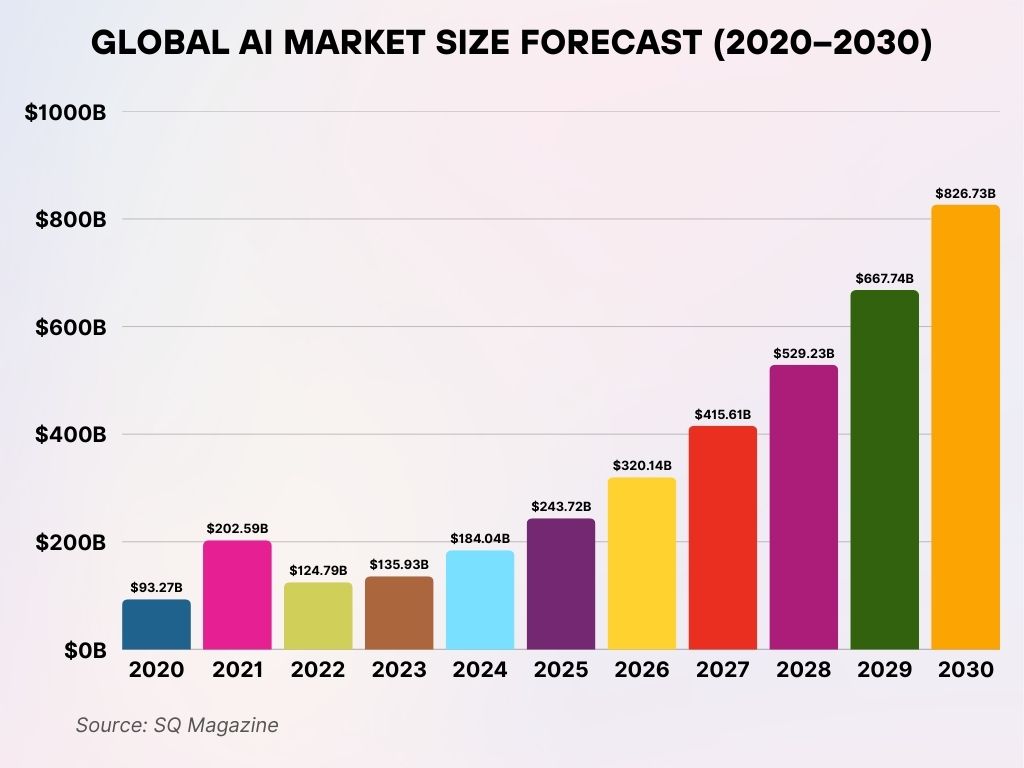
Global Market Size and Growth of AI
The scale and velocity of AI’s growth are nothing short of transformative. Here’s what the numbers show:
- The global artificial intelligence market is forecasted to reach $407 billion in 2025, marking a 23% CAGR from 2023.
- North America remains the largest market, accounting for approximately 41% of global AI revenue.
- Asia-Pacific is the fastest-growing region, with a projected market value of $105 billion by the end of 2025.
- By 2025, AI will power 80% of all digital transformation initiatives worldwide.
- The AI software market—including NLP, machine learning platforms, and computer vision—is expected to generate $188 billion in revenue by 2025.
- The AI hardware market is projected to exceed $78 billion, driven largely by AI chips and edge computing devices.
- AI-as-a-Service (AIaaS) is expected to grow to $46 billion in 2025, up from $31 billion in 2023.
- Cloud-based AI applications now represent 60% of all enterprise AI deployments.
- The AI in the retail market is expected to surpass $27 billion globally in 2025, driven by automation and personalization.
- AI in manufacturing is projected to grow by 45% year-over-year, reaching $18.6 billion in 2025.
AI Adoption Rates Across Industries
AI is no longer limited to tech firms. It’s making waves across every major sector:
- 95% of Fortune 500 companies report using AI in some capacity as of Q2 2025.
- The retail sector saw AI adoption rise to 78%, driven by demand forecasting and AI chatbots.
- In manufacturing, 68% of firms are using predictive maintenance and intelligent automation tools.
- The transportation and logistics sector reported 59% AI usage for route optimization and fleet management.
- In agriculture, over 38% of large-scale farms are deploying AI for crop analytics and autonomous machinery.
- The hospitality industry has reached 61% AI adoption, leveraging virtual assistants and AI-powered reservation systems.
- The legal field saw a 300% increase in AI usage for contract analysis and case research from 2023 to 2025.
- The construction sector reported a modest but growing 29% AI penetration, mainly in risk assessment and planning.
- In government agencies, AI usage has climbed to 52%, especially for fraud detection and citizen services.
- The energy sector now sees 47% of firms using AI for demand forecasting and grid management.
Cumulative Global AI Revenue Forecast by Use Case (2016–2025)
- Machine/vehicular object direction/identification/avoidance is forecasted to generate the highest revenue at $8,986.57 million.
- Static image recognition, classification, and tagging are expected to bring in $7,642.83 million, showing strong visual AI adoption.
- Patient data processing ranks high with a projected revenue of $7,259.35 million, highlighting AI’s role in healthcare data management.
- Algorithmic trading performance improvement is forecasted at $6,394.41 million, underlining AI’s impact on financial markets.
- Localization and mapping use cases are estimated to generate $5,950.55 million, crucial for autonomous navigation systems.
- Predictive maintenance is projected to reach $5,713.6 million, boosting operational efficiency across industries.
- Cybersecurity threat prevention is expected to bring in $5,385.1 million, emphasizing AI’s role in digital defense.
- Digital paperwork conversion is forecasted at $5,370.85 million, supporting automation in administrative processes.
- AI for recruitment and HR systems will likely earn $5,295.03 million, showing its relevance in talent management.
- Medical image analysis rounds out the list with $5,111.31 million, aiding diagnostics and treatment planning.
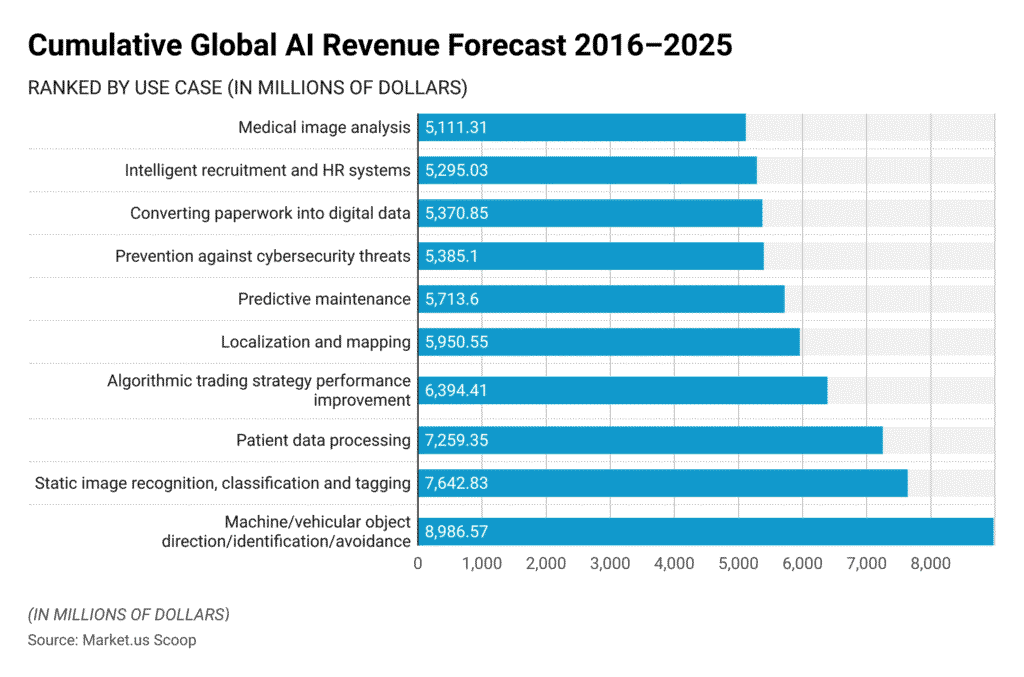
AI in Consumer Technology
AI continues to revolutionize consumer products by making them smarter, faster, and more personalized:
- By 2025, 70% of smartphones will include on-device AI chips for real-time processing.
- Smart home device penetration in the U.S. hit 65%, with voice assistants in over 110 million households.
- More than 60% of wearable tech products launched in 2025 feature AI-driven health monitoring.
- AI personalization engines are now used by 95% of streaming platforms to curate content.
- In the gaming industry, 58% of AAA game studios integrate AI for real-time NPC behavior and procedural design.
- AI camera enhancements are found in 82% of flagship smartphones released in 2025.
- Virtual assistants like Siri, Alexa, and Google Assistant handle over 3 billion voice queries daily.
- Consumer robotics, including vacuum bots and companion robots, saw a 27% YoY increase, reaching $24.5 billion in market value.
- AI-powered translation tools now support over 100 languages, used actively by over 500 million global users.
- AI in smart TVs is enabling real-time upscaling and voice interaction in 72% of units shipped globally.
AI Impact on Employment and Workforce Trends
As AI automates tasks and reshapes job roles, its influence on the workforce is undeniable, both as a disruptor and creator:
- In 2025, an estimated 83 million jobs globally are expected to be displaced by AI, while 97 million new roles will emerge due to automation and augmentation.
- The top three AI-related job titles in the U.S. are machine learning engineer, AI ethics officer, and prompt engineer.
- 37% of workers in the U.S. now use AI tools daily—up from 22% in 2023.
- By mid-2025, 65% of HR departments report using AI for candidate screening, onboarding, and retention prediction.
- Gig platforms are leveraging AI to match workers with projects, with 52% of users reporting improved job fit and satisfaction.
- AI-driven upskilling platforms have reached 30 million active learners globally in Q1 2025.
- 53% of employers believe AI will augment rather than replace their workforce, prioritizing hybrid human-machine collaboration.
- In creative industries, 42% of content is now co-generated with AI, including marketing copy, scripts, and product descriptions.
- Remote work productivity tools embedded with AI have improved time management by 34% on average, per enterprise surveys.
- Union negotiations in sectors like media and logistics increasingly include provisions around ethical AI usage and job protections.
How Business Owners Are Using AI: Key Use Cases and Adoption Rates
- 53% of business owners use AI to improve production processes, making it the most common application of AI in operations.
- 52% leverage AI for Search Engine Optimization (SEO) tasks like keyword research, reflecting its growing role in digital marketing.
- 51% rely on AI for process automation, streamlining repetitive workflows, and boosting efficiency.
- 46% integrate AI into internal communications such as plans, reports, and presentations to enhance clarity and speed.
- 40% utilize AI to aggregate business data, helping them uncover insights and trends faster.
- 38% adopt AI for idea generation, supporting creative processes and innovation.
- Another 38% use AI to minimize safety risks, especially in manufacturing or high-risk industries.
- 31% employ AI to write code, assisting in software development and rapid prototyping.
- 29% turn to AI for writing website copy, optimizing content creation for online platforms.
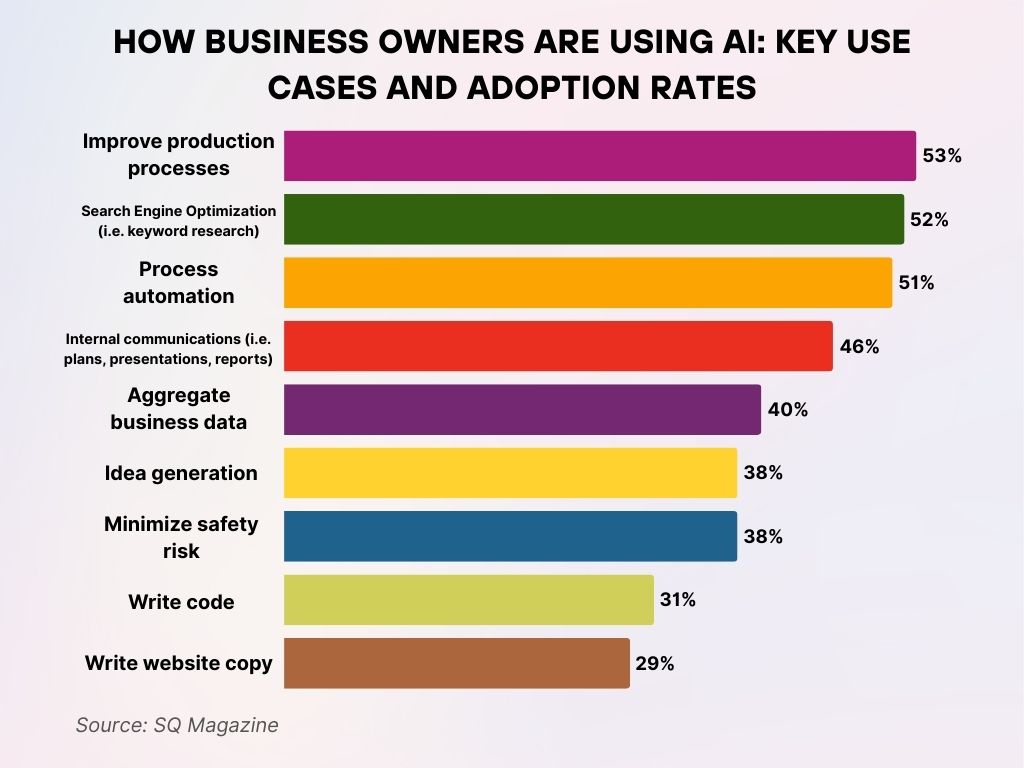
AI in Healthcare and Medical Research
AI’s role in healthcare is revolutionizing diagnostics, treatment pathways, and drug discovery with unprecedented accuracy and speed:
- AI is now used in 74% of hospitals across the U.S. for diagnostic imaging, predictive analytics, and administrative efficiency.
- By 2025, AI-assisted radiology tools can detect certain cancers with 96% accuracy, surpassing human benchmarks.
- The AI healthcare market is expected to hit $71.5 billion globally in 2025, a 32% increase from 2024.
- More than 1,200 FDA-approved AI devices are currently in use, covering fields such as cardiology, ophthalmology, and neurology.
- AI-powered mental health chatbots are used by 45 million people worldwide for therapy and wellness check-ins.
- Clinical trials leveraging AI for patient recruitment and data monitoring have seen 45% faster completions on average.
- Drug discovery processes are 70% faster in trials using generative AI for molecule design and testing.
- AI triage systems in emergency departments are reducing average wait times by 28%, according to U.S. hospital networks.
- Voice-to-text transcription tools now handle 85% of doctor-patient documentation in major healthcare facilities.
- AI in robotic surgeries grew by 40% year-over-year, with systems assisting over 800,000 procedures globally in 2025.
AI Use in Finance and Banking
The financial sector has embraced AI as a core enabler of automation, fraud detection, and customer personalization:
- Over 92% of U.S. banks have deployed AI in some capacity—up from 76% in 2023.
- AI-powered fraud detection systems are reducing unauthorized transaction losses by 38% on average.
- The AI in the fintech market is projected to surpass $42 billion by the end of 2025.
- Robo-advisors now manage over $1.3 trillion in assets, with 32 million global users.
- 71% of banking customers report AI-driven chatbots improving their service experience and reducing wait times.
- In investment banking, 48% of trade recommendations are generated or verified by AI systems.
- Credit scoring systems using AI have increased loan approval rates by 19%, especially among underserved borrowers.
- Real-time AI systems now process over 200 million financial transactions per day in North America alone.
- AI is instrumental in regulatory compliance, helping banks reduce audit errors by 27%.
- Insurance underwriting powered by AI has reduced claims processing time from 10 days to 24 hours in leading firms.
AI Revenue Forecast by Use Case (2016–2025)
- Static image recognition, classification, and tagging lead with a projected $8,097.9 million in revenue.
- Algorithmic trading strategy performance improvement follows closely at $7,540.5 million, showing strong financial sector adoption.
- Patient data processing is expected to generate $7,366.4 million, underscoring AI’s value in healthcare scalability.
- Predictive maintenance could earn $4,680.3 million, streamlining operations and reducing machine downtime.
- Object detection and classification from geospatial images are forecasted at $4,201.0 million.
- Text query of images use cases are projected to reach $3,714.1 million, advancing image-based search capabilities.
- Automated geophysical feature detection may bring in $3,655.5 million, aiding scientific and exploration efforts.
- Social media content distribution using AI is forecasted at $3,566.6 million, powering personalized digital marketing.
- Object detection and classification for navigation and avoidance are estimated to hit $3,169.8 million.
- Cybersecurity threat prevention rounds out the list with $2,472.6 million, reflecting steady demand for AI in digital security.
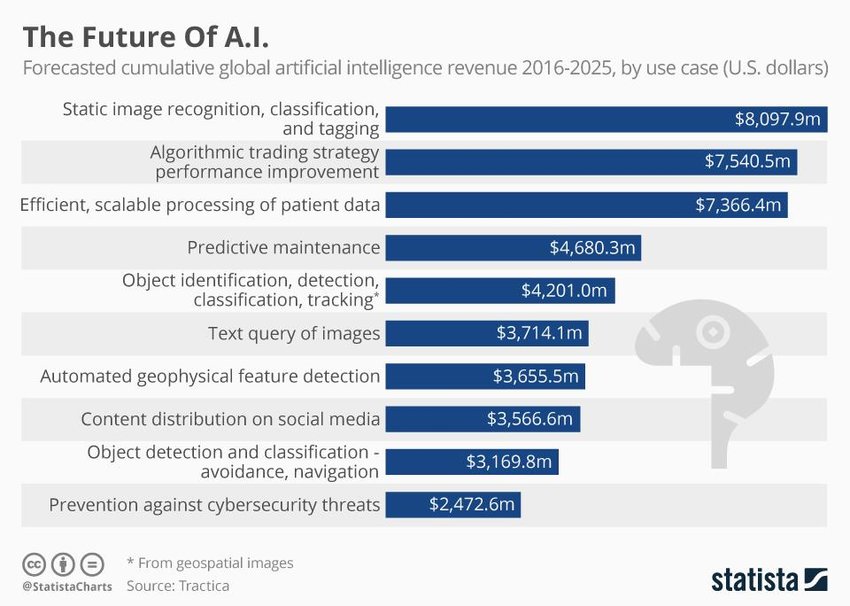
AI Ethics, Regulation, and Public Perception
As AI matures, questions of fairness, transparency, and oversight have never been more pressing:
- As of 2025, 34 countries have implemented national AI governance frameworks, up from 18 in 2023.
- In the U.S., 67% of adults express concern about biased or unethical AI decision-making.
- 72% of organizations using AI have formal AI ethics policies in place, compared to just 41% in 2022.
- The European Union’s AI Act is now fully enforceable, mandating compliance across 27 countries.
- Public trust in AI is rising, with 54% of Americans now believing AI can make fairer decisions than humans in certain contexts.
- The number of AI-related lawsuits globally reached 220 cases in 2024, focused largely on data privacy and algorithmic bias.
- Tech giants now dedicate an average of $300 million annually to AI safety and ethics R&D.
- Generative AI systems are required to disclose synthetic content in 6 out of 10 major economies.
- 47% of AI professionals report receiving mandatory ethics training in 2025—a jump from 26% two years ago.
- Citizen-led AI oversight committees are active in over 80 cities worldwide, guiding municipal AI deployments.
AI Investment and Funding Statistics
Funding in AI is booming, with capital flooding into foundational models, vertical-specific AI, and infrastructure:
- Global investment in AI startups reached $284 billion in 2024, with forecasts suggesting $310 billion in 2025.
- The U.S. leads AI venture funding, with $143 billion raised in 2024, comprising 50% of global AI VC deals.
- The top 10 AI unicorns in 2025 have a combined valuation of over $380 billion.
- Corporate AI R&D budgets grew by 25% YoY, now averaging $11.2 billion annually among Fortune 100 companies.
- Generative AI accounted for 35% of total AI funding in 2025, driven by advancements in multimodal models.
- Vertical AI (industry-specific solutions) attracted $47 billion in investment in areas like legal tech, edtech, and health tech.
- Over 900 AI-focused funds are active globally, including sovereign wealth and pension-backed vehicles.
- Asia-based AI startups raised $62 billion in 2024—a 19% increase, with much of it coming from Japan, India, and South Korea.
- Mergers and acquisitions in the AI space reached a record high of $77 billion across 590 deals in 2024.
- Government-backed AI funding in the U.S. exceeded $18 billion, with major grants supporting AI safety, education, and infrastructure.
How Smartphone Users Benefit from AI: Awareness vs. Usage
- Predictive text had the highest awareness at 50%, with 35% of users actively using it for typing efficiency.
- Route suggestions were known by 39% of users and used by 24%, showing strong AI integration in navigation.
- Voice assistants saw 37% awareness, but only 12% usage, suggesting a gap between recognition and trust in use.
- Voice search had 31% awareness with just 9% usage, indicating potential for growth in AI-powered search.
- Translation apps were known to 25% of users, with 11% actually using them, useful for travel and communication.
- Voice-to-text features were recognized by 25%, yet used by only 7%, despite convenience in hands-free messaging.
- Email classification awareness was at 23%, with 12% utilizing AI to organize inboxes efficiently.
- Automated calendar entries had 21% awareness and 10% usage, highlighting moderate adoption in productivity tasks.
- Location-based app suggestions were least known at 20%, with only 5% usage, suggesting low reliance on contextual AI.
- Automated photo classification was equally known (20%) but had slightly higher 9% usage, helpful in photo organization.

AI in Education and Learning Technologies
AI is redefining how we teach and learn, with adaptive systems personalizing education at scale:
- By 2025, over 60% of U.S. schools will use AI-driven platforms for personalized learning and assessment.
- AI-based tutoring platforms now serve over 300 million students globally, offering 24/7 support in multiple languages.
- Predictive analytics tools are reducing dropout rates by 22% across higher education institutions.
- 58% of educators say AI has improved their ability to deliver individualized instruction.
- AI proctoring tools are used in 75% of online certification exams, ensuring integrity with real-time monitoring.
- Language learning apps powered by AI—like Duolingo and Babbel—saw user growth of 48% year-over-year.
- Adaptive testing, where AI tailors question difficulty, is now standard in 35% of U.S. standardized testing environments.
- Universities are offering AI literacy modules as part of the core curriculum, up from 18% in 2023 to 42% in 2025.
- AI-enabled career guidance systems have improved student placement rates by 31% in participating programs.
- Educational publishers report that over 50% of new textbooks are now supplemented with AI-enhanced content platforms.
AI and Cybersecurity Integration
AI is rapidly becoming both a shield and a target in the world of cybersecurity, offering enhanced protection while introducing new vulnerabilities:
- 81% of cybersecurity professionals report using AI to detect and respond to threats in real time.
- AI-powered threat detection systems now identify intrusions 92% faster than traditional methods.
- In 2025, the AI in cybersecurity market is valued at $27.3 billion, growing at a 21.4% CAGR.
- AI is responsible for filtering out 88% of spam and phishing emails across major email providers.
- Predictive AI models prevented an estimated $12 billion in fraud attempts globally during the first half of 2025.
- 42% of ransomware detection systems are now fully AI-driven, reducing average incident response time to under 4 hours.
- AI is increasingly used to secure IoT devices, with 58% of smart home networks incorporating embedded AI security features.
- AI-generated deepfakes are on the rise, prompting 41% of global organizations to adopt AI-based content authentication tools.
- Cybersecurity AI tools are now deployed in 78% of U.S. government IT systems.
- Zero-trust security frameworks powered by AI are reducing insider threats by 33%, according to enterprise IT audits.
Potential Benefits of AI According to Survey Respondents
- 43.1% of respondents believe AI can increase productivity, making it the most widely recognized benefit.
- 39.4% see AI as a way to enhance decision-making, improving strategic and operational outcomes.
- 35.3% cited AI’s ability to reduce the risk of errors, boosting reliability in tasks and workflows.
- 34.0% value AI for reducing response time, especially in handling customer service queries.
- 30.9% identified AI’s role in streamlining job processes, automating routine work for efficiency.
- 30.8% say AI helps to improve customer relationships, likely through personalization and faster support.
- 25.3% consider cost savings as a major advantage of AI adoption.
- 19.6% believe AI has the potential to increase sales, linking it to revenue generation.
- 4.1% responded none of the above, indicating minimal perceived benefit or skepticism.
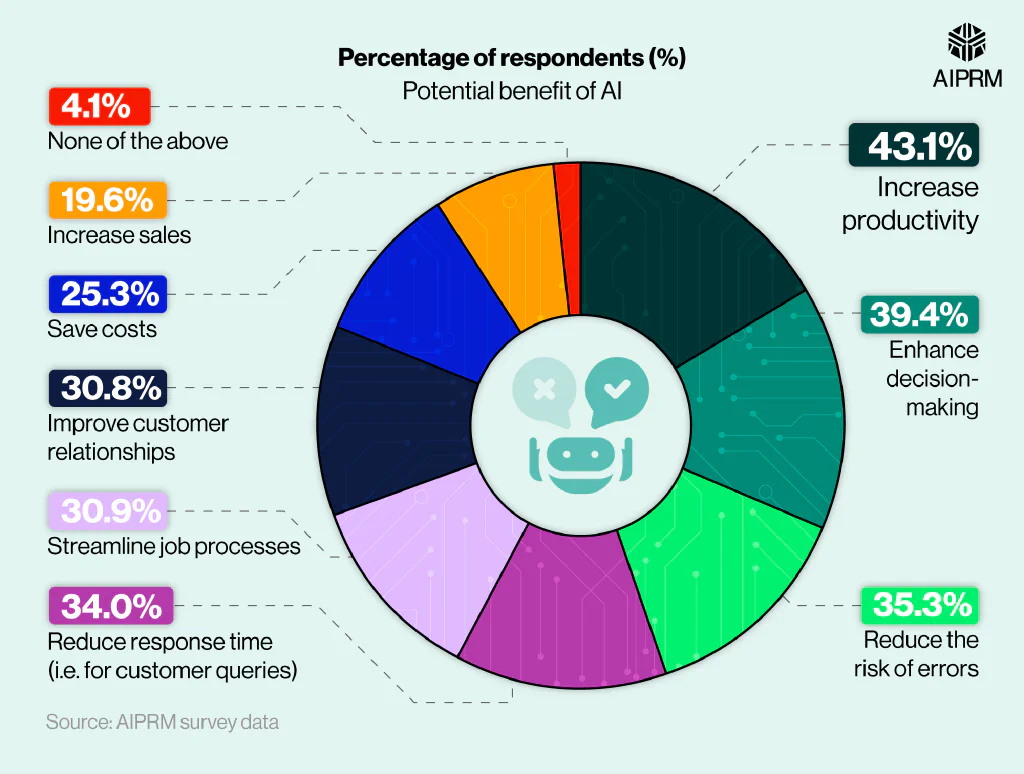
Leading Countries in AI Development
While AI is a global phenomenon, a few countries are clearly leading the innovation race in 2025:
- The United States remains the global leader in AI, accounting for 41% of total AI patents filed worldwide in 2024.
- China holds the second position, filing over 88,000 AI patents in the last two years and investing more than $65 billion in state-driven AI initiatives.
- India has emerged as a major AI hub, with $12.6 billion in AI startup funding and over 1 million AI-skilled professionals.
- The European Union collectively contributes 21% of global AI research papers, led by Germany, France, and the Netherlands.
- Israel continues to be a leader in AI cybersecurity innovation, hosting over 1,100 AI startups in 2025.
- South Korea ranks among the top five AI research nations, with national initiatives driving advancements in AI robotics and language processing.
- Singapore boasts the highest per capita investment in AI R&D, with government programs supporting AI in healthcare and education.
- Canada plays a key role in foundational AI research, particularly in deep learning and ethics, with over 250 active AI labs.
- Japan is focused on AI for aging populations, with robotic AI integrations used in 62% of elderly care facilities.
- United Kingdom AI exports reached $8.9 billion, with a heavy focus on fintech and AI governance expertise.
Popular AI Tools and Platforms in Use
From no-code platforms to sophisticated development environments, these tools are powering AI innovation in 2025.
- OpenAI’s GPT-5 is the most widely used foundation model, deployed by 78% of Fortune 500 companies.
- Google DeepMind’s Gemini series now leads in multimodal capabilities, supporting voice, video, and text integration.
- Anthropic’s Claude 3 has grown by 290% in enterprise usage, particularly in regulated industries.
- Hugging Face now hosts over 500,000 models, making it the largest open-source AI repository globally.
- Microsoft Copilot is active across 68% of corporate Microsoft 365 accounts, streamlining workflows with AI.
- Amazon Bedrock enables enterprises to customize foundation models at scale, now available in 22 countries.
- Midjourney and Runway dominate the generative image and video space, serving millions of creators monthly.
- IBM WatsonX focuses on enterprise-grade AI governance, adopted by over 1,200 financial institutions.
- Cohere, a leader in retrieval-augmented generation (RAG), powers customer service platforms for 30,000+ brands.
- Pinecone and Weaviate lead in vector database adoption, enabling AI applications to handle long-context queries and memory.
Accuracy and Performance Metrics of AI Models
Accuracy, interpretability, and model robustness are under a microscope as AI applications expand into high-stakes environments.
- GPT-5 reaches an accuracy score of 93.2% on the MMLU benchmark, the highest among general-purpose models.
- AI models are now capable of achieving 95%+ accuracy in financial forecasting when paired with proprietary datasets.
- The average inference latency for leading LLMs dropped to 89 milliseconds, enabling near real-time response.
- AI voice recognition systems surpass 98% accuracy in U.S. English and 92% in multilingual environments.
- In medical imaging, leading models reach AUC scores above 0.97, surpassing human diagnostic rates in several fields.
- AI-powered resume screening tools now match candidate fit with 84% accuracy, according to hiring analytics platforms.
- Generative image models achieve 98% alignment with text prompts, based on user satisfaction benchmarks.
- Transformer-based models now outperform classical ML models by 4.5x on time-series tasks like demand prediction.
- Reinforcement learning agents in logistics improve operational efficiency by up to 38% across tested deployments.
- Bias detection tools built into modern AI systems have reduced algorithmic discrimination errors by 44% year-over-year.
Recent Developments in Artificial Intelligence
AI continues to push boundaries, evolving with surprising speed and scale:
- Open-source AI is booming: more than 70% of new models released in Q1 2025 are open-source, reflecting a shift toward transparent innovation.
- AI copilots are now embedded into 40% of enterprise software suites, offering real-time insights and action suggestions.
- Generative AI for video has become mainstream, with platforms producing 30-second high-res clips in under 10 seconds.
- Synthetic data generation has increased 7x since 2023, supporting faster, safer AI training across industries.
- Agentic AI systems capable of planning and acting autonomously are being piloted in robotics, finance, and sales.
- AI is now powering emotion recognition in real time across retail, education, and HR platforms.
- Bio-AI integration has begun, with early applications in drug design, gene editing, and synthetic biology.
- The first AI-to-AI negotiation systems are live in logistics and supply chain management, cutting costs and increasing transparency.
- New AI safety measures include auditable model logs, AI watermarking, and open evals to test alignment with human goals.
- AI-generated content now comprises 34% of all digital media online, up from 12% in 2023.
Conclusion
AI in 2025 isn’t just a trend—it’s a technological movement reshaping how we live, work, and innovate. From medicine and finance to education and entertainment, artificial intelligence is the backbone of digital progress. Yet, its rapid rise also brings with it deep questions about bias, regulation, employment, and ethics. Whether you’re a business leader, policy maker, or everyday user, understanding these statistics is essential for navigating the AI-powered world ahead.
As we look to the future, one thing is clear: AI will continue to accelerate, surprise, and challenge us, and staying informed is the smartest strategy of all.
Sources
- https://www.statista.com/topics/3104/artificial-intelligence-ai-worldwide/
- https://www.statista.com/outlook/tmo/artificial-intelligence/worldwide
- https://www.vox.com/future-perfect/414087/artificial-intelligence-openai-ai-2027-china
- https://www.bworldonline.com/special-features/2025/05/30/676062/exploring-artificial-intelligences-potential-in-businesses/
- https://theconversation.com/the-biggest-barrier-to-ai-adoption-in-the-business-world-isnt-tech-its-user-confidence-257308
- https://www.forbes.com/sites/teddymcdarrah/2025/05/30/a-prelude-to-the-ethics-of-artificial-intelligence/

